![]()
![]()
![]()
Use LEFT and RIGHT arrow keys to navigate between flashcards;
Use UP and DOWN arrow keys to flip the card;
H to show hint;
A reads text to speech;
19 Cards in this Set
- Front
- Back
|
What is a performance appraisal?
|
The identification, measurement and management of human performance in organizations.
|
|
|
What is a dimension with respect to job evals?
|
An aspect of performance
that determines effective job performance. |
|
|
What are the benefits of performance appraisals to the employer?
|
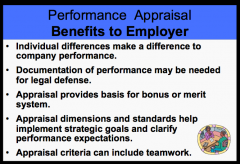
|
|
|
What are the benefits of performance appraisals to the employee?
|

|
|
|
Appraisal formats can be classified in two ways: (1) by the type of judgment that is required (_______ or _______) and (2) by the focus of the measure (_______, _______, or _______). These are known as measurement tools.
|
1. relative or absolute
2. trait, behavior, or outcome |
|
|
What is the difference between relative and absolute judgement?
|
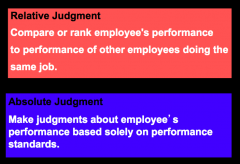
|
|
|
What are the advantages and disadvantages of relative judgment?
|
ADVAN:
Relative rating systems have the advantage of forcing supervisors to differentiate among their workers. Without such a system, many supervisors are inclined to rate everyone the same, which destroys the appraisal system’s value. DISADVAN: First, relative judgments (such as ranks) do not make clear how great or small the differences between employees are. Second, such systems do not provide any absolute information, so managers cannot determine how good or poor employees at the extreme rankings are. Third, relative ranking systems force managers to identify differences among workers where none may truly exist.This can cause conflict among workers if and when ratings are disclosed. Finally, relative systems typically require assessment of overall performance. The “big picture” nature of relative ratings makes performance feedback ambiguous and of questionable value to workers who would benefit from specific information. |
|
|
What are the advantages and disadvantages of absolute judgment?
|
ADVAN:
1- allow employees from different work groups, rated by different managers, to be compared to one another. 2- because ratings are made on separate dimensions of performance, the feedback to the employee can be more specific and helpful 3- Absolute formats are also viewed as more fair than relative formats 4** - They avoid creating conflict among workers. DISADVAN: 1. One is that all workers in a group can receive the same evaluation if the supervisor is reluctant to differentiate among workers. 2. Another is that different supervisors can have markedly different evaluation standards. |
|
|
What is trait appraisal? (focus of the measure format)
What are the problems with it? |
Making judgments about worker characteristics that tend to be consistent and enduring. (e.g.: decisiveness, reliability, energy, loyalty, leadership).
Problems are that it is subjective (one person's definition of reliability is likely different from someone else's), difficult to defend, and focuses on the person rather than the performance |
|
|
What is a behavioral appraisal? (focus of the measure format)
|
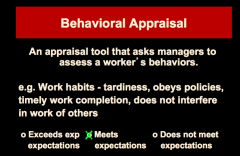
ADVANS:
The main advantage of a behavioral approach is that the performance standards are unambigu- ous and observable. Behavioral scales also provide employees with specific examples of the types of behaviors to engage in (and to avoid) if they want to do well in the organization, and they encourage supervisors to be specific in their performance feedback. DISADVANS: Developing them can be very time consuming, easily taking several months. Another disadvantage is their specificity. The points, or anchors, on behavioral scales are clear and concrete, but they are only examples of behavior a worker may exhibit Significant organizational changes can invalidate behavioral scales (e.g. obsolescence) |
|
|
What is an outcome appraisal?
|
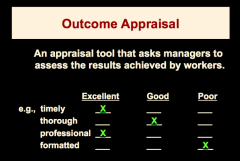
ADVANS:
1- The outcome approach provides clear and unambiguous criteria by which worker performance can be judged. 2- It also eliminates subjectivity and the potential for error and bias that goes along with it. 3- In addition, outcome approaches provide increased flexibility (a worker’s objectives can easily be adjusted at the beginning of a new evaluation period if organizational changes call for new emphases) 4** - the most important thing is that outcomes can easily be tied to strategic objectives. DISADVANS: 1- outcome measures may give a seriously deficient and distorted view of worker performance levels (e.g. if a machine broke down and your numbers went down) 2- the development of a “results at any cost” mentality. Using objective measures has the advantage of focusing workers’ attention on certain outcomes, but this focus can have negative effects on other facets of per- formance. (potential to focus on quantity versus quality, etc) |
|
|
What are the challenges to effective performance management?
|
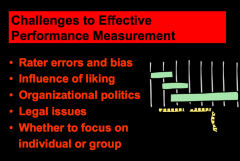
|
|
|
How can a company lesson the potential for legal issues?
|
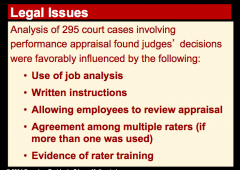
|
|
|
Describe how communication should be in performance appraisals
|
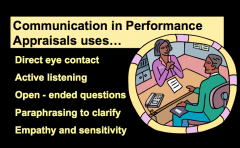
|
|
|
What are the main causes of problems at work?
How can we classify the main kinds of problems? |

Main kinds of problems classification:
1. Ability Problems 2. Effort Problems 3. Situational Problems |
|
|
How can we identify and correct ability problems?
|

|
|
|
How can we identify and correct effort problems?
|
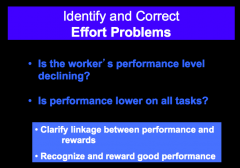
|
|
|
How can we identify and correct situational problems?
|
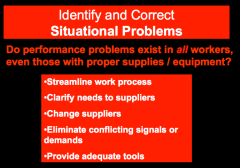
|
|
|
Describe the 360 degree feedback process
|
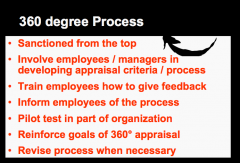
The combination of peer, subordinate, and self-review
|

